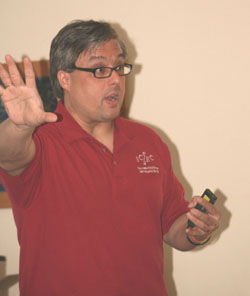
The good news is that Idyllwild sits, for the most part, on bedrock granite created through tectonic action of the two faults. Seismic waves pass more rapidly through granite, thereby reducing shaking duration. The good news is also that the San Andreas’ southern section has not produced a giant quake in nearly 400 years.
The long slumber of the southern San Andreas is also the bad news. The northern and central sections of the fault erupt in a major shake on average every 150 to 180 years. U.S. Geological Survey Cal Tech scientists recently predicted a giant 8-point or greater quake on the San Andreas southern section within the next 30 years to a 99 percent certainty.
The bad news is even Hill granite may not provide the relative shaking insulation other earthquake experts have discussed in interviews. De Groot stressed shaking duration and strength could vary widely depending on the specific area’s soil and ground composition. University of California Riverside Associate Professor of Geophysics David Oglesby suggested that many parts of the Idyllwild area, situated on granite, would be among the best places to be during a large earthquake because there would be no liquefaction or collapsing of soil structure. “Garner Valley, on the other hand, sits on an old lakebed,” noted Oglesby. “There would be a pretty high degree of motion.”
As background for his discussion, de Groot used the earthquake scenario for the 2008 Great California Shakeout. Although the USGS 7.8 magnitude scenario created major devastation along the Interstate 10 and Highway 101 corridors, the map of the ground motion (http://earthquake.usgs.gov/regional/nca/simulations/shakeout) showed comparatively less shaking and potential damage on the Idyllwild side of the mountain.
The likely damage is in the range of levels VI through VIII as measured on the Modified Mercalli Intensity Scale. Idyllwild would feel initial intimations of a Salton Sea epicenter quake about 17 seconds after the eruption and would experience Level VI moderate shaking (falling objects) about 27 seconds later. Level VII strong shaking (nonstructural damage, falling plaster, weak chimney collapses) would be felt 31 seconds after the initial quake. Very strong level VIII shaking (moderate damage, extensive to unreinforced masonry buildings, wood frame houses move on foundations if not bolted down, loose partition walls thrown out, and tree branches down) could occur about 40 seconds after the quake began (shaking classification source from the Association of Bay Area Governments, http://www.abag.ca.gov).
De Groot said a 7.8 quake on the San Andreas could produce about 2 and a half minutes of shaking. Damage to Idyllwild would depend on three things — quake magnitude, distance from the quake epicenter, and the local material upon which different Idyllwild areas are situated.
Also in the bad news category is that the greater danger posed to Idyllwild is not from the San Andreas fault but from the San Jacinto Fault network that runs closer to Idyllwild, said de Groot. The SJF experiences major quakes far more frequently than the San Andreas, some in the major quake range. “Even siting on the most solid ground, if a major quake goes through the San Jacinto fault, it could still take the [Idyllwild] area out,” he said.
The San Jacinto has generated four large quakes since 1899 when a 6.4 quake shook the Hemet/San Jacinto area. Three subsequent quakes were a 6.9M in 1918, a 6.3 shaker in 1923 further north near San Bernardino and Redlands and a 6.5 event near Borrego Mountain. The most recent quake, in 2010, was a moderate one in Borrego Springs, at 5.4M. Just for reference, de Groot said a 6-point quake is 30 times more powerful that of a 5; a 7-point is 900 times more powerful than a 6; and an 8-point quake (very possible on the San Andreas because of the southern section’s length) is 27,000 time more powerful than a 6. The very destructive Northridge quake was a 6.7 magnitude.
De Groot strongly emphasized the value of earthquake preparedness, with information available through the U.S. Geological Survey at http://earthquake.usgs.gov/learn/faq/?categoryID=14.










